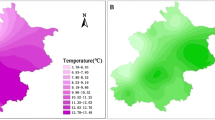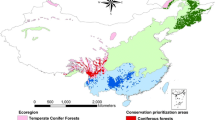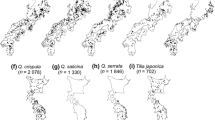Abstract
We built a classification tree (CT) model to estimate climatic factors controlling the cold temperate coniferous forest (CTCF) distributions in Yunnan province and to predict its potential habitats under the current and future climates, using seven climate change scenarios, projected over the years of 2070-2099. The accurate CT model on CTCFs showed that minimum temperature of coldest month (TMW) was the overwhelmingly potent factor among the six climate variables. The areas of TMW<-4.05 were suitable habitats of CTCF, and the areas of -1.35 < TMW were non-habitats, where temperate conifer and broad-leaved mixed forests (TCBLFs) were distribute in lower elevation, bordering on the CTCF. Dominant species of Abies, Picea, and Larix in the CTCFs, are more tolerant to winter coldness than Tsuga and broad-leaved trees including deciduous broad-leaved Acer and Betula, evergreen broad-leaved Cyclobalanopsis and Lithocarpus in TCBLFs. Winter coldness may actually limit the cool-side distributions of TCBLFs in the areas between -1.35°C and -4.05°C, and the warm-side distributions of CTCFs may be controlled by competition to the species of TCBLFs. Under future climate scenarios, the vulnerable area, where current potential (suitable + marginal) habitats (80,749 km2) shift to non-habitats, was predicted to decrease to 55.91% (45,053 km2) of the current area. Inferring from the current vegetation distribution pattern, TCBLFs will replace declining CTCFs. Vulnerable areas predicted by models are important in determining priority of ecosystem conservation.
Similar content being viewed by others
References
Berry PM, Rounsevell DA, Harrison PA, et al. (2006) Assessing the vulnerability of agricultural land use and species to climate change and the role of policy in facilitating adaptation. Environmental Science & Policy 9(2): 189–204. DOI: 10.1016/j.envsci.2005.11.004
Clark LA, Pregibon D (1992) Tree-based models. In:Chambers JM, Hastie TJ. Statistical models in S. Wadsworth & Brooks/Cole advanced books & soft-ware. Pacific Grove, California. pp 377–419.
Efron B (1979) Bootstrap methods: another look at the jackknife. The Annals of Statistics 7(1): 1–26. DOI: 10.1214/aos/1176344552
Euskirchen EA, Mc Guire F, Chapin IS, et al. (2009) Changes in vegetation in northern Alaskaunder scenarios of climate change, 2003-2100: implications for climate feedbacks. EcologicalApplications 19: 1022–1043. DOI: 10.1890/08-0806.1
Higa M, Nakao K, Tsuyama I, et al. (2013a) Indicator plant species selection for monitoring the impact of climate change based on prediction uncertainty. Ecological Indicators 29: 307–315. DOI: 10.1016/j.ecolind.2013.01.010
Higa M, Tsuyama I, Nakao K, et al. (2013b) Influence of nonclimatic factors on the habitat prediction of tree species and an assessment of the impact of climate change. Landscape and Ecological Engineering 9: 111–120. DOI: 10.1007/s11355-011-0183-y
Hijmans RJ, Cameron SE, Parra JL, et al. (2005) Very high resolution interpolated climate surfaces for global land areas. International Journal of Climatology 25: 1965–1978.
Horikawa M, Tsuyama I, Matsui T, et al. (2009) Assessing the potential impacts of climate change on the alpine habitat suitability of Japanese stone pine (Pinus pumila). Landscape Ecology 24: 115–128. DOI: 10.1007/s10980-008-9289-5
Iverson LR, Prasad AM, Schwartz MW (2005) Predicting potential changes in suitable habitat and distribution by 2100 for tree species of the eastern United States. Journal of Agricultural Meteorology 61: 29–37.
Leathwick JR, Whitehead D, McLeod M (1996) Predicting changes in the composition of New Zealand’s indigenous forests in response to global warming: a modelling approach. Environmental Software 11: 81–90. DOI: 10.1016/S0266-9838 (96)00045-7
Li WJ, Peng MC, Pan HZ, et al. (2013) Landscape pattern in Honghe River bas in based on moving window method. Journal of Anhui Agriculture Science 41(10): 4455–4457. (In Chinese).
Liu Q, Wu N, Cheng QH (2000) Exploration of non-equilibrium of subalpine conifer forests ecosystem in western China. World Science-technology R&D 22: 58–63. (In Chinese).
McCarthy JJ, Canziani OF, Leary NA, et al. (2001) Climate change 2001: Impacts, adaptation, and vulnerability. Cambridge University Press, New York, NY, USA.
Matsui T, Nakaya T, Yagihashi T, et al. (2004a) Comparing the accuracy of predictive distribution models for Fagas crenata forest in Japan. Japanese JournalFor Environment 46: 93–102.
Matsui T, Yagihashi T, Nakaya T, et al. (2004b) Climatic controls on distribution of Fagus crenata forests in Japan. Journal of Vegetation Science 15: 57–66. DOI: 10.1111/j.1654-1103.2004.tb02237.x
Matsui T, Yagihashi T, Nakaya T, et al. (2004c) Probability distributions, vulnerability and sensitivity in Fagus crenata forests following predicted climate changes in Japan. Journal of Vegetation Science 15: 605–614. DOI: 10.1111/j.1654-1103.2004.tb02302.x
Metz CE (1978) Basic principles of ROC analysis. Seminars in nuclear medicine 8: 283–298. DOI: 10.1016/S0001-2998(78) 80014-2
Nakao K, Higa M, Tsuyama I, et al. (2013) Spatial conservation planning under climate change: Using species distribution modeling to assess priority for adaptive management of Fagus crenata in Japan. Journal for Nature Conservation 21: 406–413.
Nakao K, Matsui T, Tanaka N, et al. (2009) Climatic controls of the distribution and abundance of two evergreen Quercus species in Japan. Japanese Journal For Environment 51(1): 27–37.
Ohsawa M (1990) An interpretation of latitudinal patterns of forest limits in South and East Asian mountains. Journal of Ecology 78: 326–339.
Ohsawa M (1993) Latitudinal pattern of mountain vegetation zonation in southern and eastern Asia. Journal of Vegetation Science 4: 13–18.
Parmesan C, Yohe G (2003) A globally coherent fingerprint of climate change impacts across natural systems. Nature 421: 37–42.
Pearson RG, Dawson TP, Liu C (2008) Modelling species distributions in Britain: a hierarchical integration of climate and land cover data. Ecography 27: 285–298. DOI: 10.1111/j.0906-7590.2004.03740.x
Peng MC, Ou GL, Wang CY, et al. (2013) Research on the vegetation landscape pattern of the core area of the Three Pa rallel rivers Belt in Gongshan county of Yunnan province. Guangxi Agricultural Sciences 24: 141–147. (In Chinese)
Ranjitkar S, Sujakhu MN, Yang L, et al. (2016) Climate modelling for agro forestry species selection in Yunnan Province, China. Environmental Modelling and Software 75: 263–272. DOI: 10.1016/j.envsoft.2015.10.027
Rouget M, Richardson DM, Lavorel S, et al. (2001) Determinants of distribution of six Pinus species inCatalonia, Spain. Journal of Vegetation Science 12: 491–502. DOI: 10.2307/3237001
Sakai A (1975) Freezing resistance of evergreen and deciduous broad-leaf trees in Japan with specialreference to their distributions. Japanese Journal of Ecology 25: 101–111.
Sakai A and Malla B (1981) Winter hardiness of tree species at high altitude in the East Himalaya, Nepal. Ecology 62: 1288–1298.
Scinocca JN, McFarlane MA, Lazare M, et al. (2008) Technical Note: The CCCma third generation AGCM and its extension into the middle atmosphere. Atmospheric Chemistry and Physics 8: 7055–7074. DOI: 10.5194/acp-8-7055-2008
Shafer S L, Bartlein P, Tompson R (2001) Potential changes in the distributions of western north america tree and shrub taxa under future climate scenarios. Ecosystems 4(3): 200–215. DOI: 10.1007/s10021-001-0004-5
Swets J A (1988) Measuring the accuracy of diagnostic systems. Science 240: 1285–1293. DOI: 10.1126/science.3287615
Tanaka N, Nakao K, Tsuyama I, et al. (2012) Predicting the impact of climate change on potentialhabitats of fir (Abies) species in Japan and on the East Asian continent. Procedia EnvironmentalSciences 13: 455–466.
Tanaka N, Matsui T, Yagihashi T, et al. (2006) Climatic controls on natural forest distribution andpredicting the impact of climate warming:Especially referring to Buna (Fagus crenata) forests. Global Environmental Research 10(2): 151–160.
Tanaka N, Nakazono E, Tsuyama I, et al. (2009) Assessing impact of climate warming on potential habitats of ten conifer species in Japan. Tikyu-kankyo 14: 153–164 (In Japanese).
Tang CQ (2015) The subtropical vegetation of southwestern China: plant distribution, diversity and ecology. Plants and Vegetation, Vol. 11. Springer, Dordrecht. DOI: 10.1007/978-94-017-9741-2
Venables WN, Ripley BD (1999) Modern applied statistics with S-Plus. Springer, New York, NY, USA.
Tsuyama I, Nakao K, Matsui T, et al. (2011) Climatic controls of a keystone understory species, Sasamorpha borealis, and an impact assessment of climate change in Japan. Annals of Forest Science 68: 689–699. DOI: 10.1007/s13595-011-0086-y
Walker BH, Steffen WL, Canadell J, et al. (1999) The terrestrial biosphere and global change: Implications for natural and managed ecosystems. Cambridge University Press, Cambridge, UK. p 142.
Wang J (1990) Statistical analysis of temperatures of both the upper and lower bounds of sub-alpine dark conifer forests in China.Scientia Geographica Sinica 10(2): 142–149. (In Chinese)
Wu ZY (2010) Flora Republicae Popularis Sinicae. Science Press, Beijing, China. pp 498–501. (In Chinese)
Wu ZY, Zhu YC, Jiang HQ (1987) Yunnan vegetation. Science Press, Beijing, China. pp 472–473. (In Chinese)
Woodward FI (1987) Climate and plant distribution. Cambridge University Press, New York, NY, USA. pp 52–54.
Zhang MG, Zhou ZK, Chen WY, et al. (2012) Using species distribution modeling to improve conservation and land use planning of Yunnan, China. Biological Conservation 153: 257–264. DOI:10.1016/j.biocon.2012.04.023
Zomer RJ, Xu J, Wang MC, et al. (2015) Projected impact of climate change on the effectiveness of the existing protected area network for biodiversity conservation within Yunnan province, China. Biological Conservation 184: 335–345. DOI: 10.1016/j.biocon.2015.01.031
Author information
Authors and Affiliations
Corresponding author
Additional information
http://orcid.org/0000-0003-1234-6546
http://orcid.org/0000-0001-7938-2395
http://orcid.org/0000-0003-3406-999X
http://orcid.org/0000-0001-8703-5967
http://orcid.org/0000-0002-8626-3199
http://orcid.org/0000-0003-3789-6771
http://orcid.org/0000-0001-7069-0279
http://orcid.org/0000-0003-1232-1656
http://orcid.org/0000-0002-3947-7370
http://orcid.org/0000-0002-1239-0128
Rights and permissions
About this article
Cite this article
Li, Wj., Peng, Mc., Higa, M. et al. Effects of climate change on potential habitats of the cold temperate coniferous forest in Yunnan province, southwestern China. J. Mt. Sci. 13, 1411–1422 (2016). https://doi.org/10.1007/s11629-016-3846-1
Received:
Revised:
Accepted:
Published:
Issue Date:
DOI: https://doi.org/10.1007/s11629-016-3846-1




